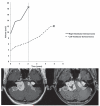Long-term natural history of neurofibromatosis Type 2-associated intracranial tumors
- PMID: 22503123
- PMCID: PMC4749021
- DOI: 10.3171/2012.3.JNS111649
Long-term natural history of neurofibromatosis Type 2-associated intracranial tumors
Abstract
Object: Neurofibromatosis Type 2 (NF2) is a heritable tumor predisposition syndrome that leads to the development of multiple intracranial tumors, including meningiomas and schwannomas. Because the natural history of these tumors has not been determined, their optimal management has not been established. To define the natural history of NF2-associated intracranial tumors and to optimize management strategies, the authors evaluated long-term clinical and radiographic data in patients with NF2.
Methods: Consecutive NF2 patients with a minimum of 4 years of serial clinical and MRI follow-up were analyzed.
Results: Seventeen patients, 9 males and 8 females, were included in this analysis (mean follow-up 9.5±4.8 years, range 4.0-20.7 years). The mean age at initial evaluation was 33.2±15.5 years (range 12.3-57.6 years). Patients harbored 182 intracranial neoplasms, 164 of which were assessable for growth rate analysis (18 vestibular schwannomas [VSs], 11 nonvestibular cranial nerve [CN] schwannomas, and 135 meningiomas) and 152 of which were assessable for growth pattern analysis (15 VSs, 9 nonvestibular CN schwannomas, and 128 meningiomas). New tumors developed in patients over the course of the imaging follow-up: 66 meningiomas, 2 VSs, and 2 nonvestibular CN schwannomas. Overall, 45 tumors (29.6%) exhibited linear growth, 17 tumors (11.2%) exhibited exponential growth, and 90 tumors (59.2%) displayed a saltatory growth pattern characterized by alternating periods of growth and quiescence (mean quiescent period 2.3±2.1 years, range 0.4-11.7 years). Further, the saltatory pattern was the most frequently identified growth pattern for each tumor type: meningiomas 60.9%, VSs 46.7%, and nonvestibular schwannoma 55.6%. A younger age at the onset of NF2-related symptoms (p=0.01) and female sex (p=0.05) were associated with an increased growth rate in meningiomas. The identification of saltatory growth in meningiomas increased with the duration of follow-up (p=0.01).
Conclusions: Neurofibromatosis Type 2-associated intracranial tumors most frequently demonstrated a saltatory growth pattern. Because new tumors can develop in NF2 patients over their lifetime and because radiographic progression and symptom formation are unpredictable, resection may be best reserved for symptom-producing tumors. Moreover, establishing the efficacy of nonsurgical therapeutic interventions must be based on long-term follow-up (several years).
Figures


Comment in
-
Natural history of neurofibromatosis Type 2 tumors.J Neurosurg. 2012 Jul;117(1):107-8; discussion 108. doi: 10.3171/2012.1.JNS112304. Epub 2012 Apr 13. J Neurosurg. 2012. PMID: 22503124 No abstract available.
Similar articles
-
Growth Dynamics of Intracranial Tumors in Patients with Neurofibromatosis Type 2.World Neurosurg. 2017 Feb;98:152-161. doi: 10.1016/j.wneu.2016.10.060. Epub 2016 Oct 21. World Neurosurg. 2017. PMID: 27777160
-
Pediatric cerebellopontine angle and internal auditory canal tumors: clinical article.J Neurosurg Pediatr. 2013 Oct;12(4):317-24. doi: 10.3171/2013.6.PEDS1383. Epub 2013 Aug 2. J Neurosurg Pediatr. 2013. PMID: 23909617
-
Distribution of nonvestibular cranial nerve schwannomas in neurofibromatosis 2.Otol Neurotol. 2007 Dec;28(8):1083-90. doi: 10.1097/MAO.0b013e31815a8411. Otol Neurotol. 2007. PMID: 18043434
-
Neurofibromatosis Type 2 (NF2) and the Implications for Vestibular Schwannoma and Meningioma Pathogenesis.Int J Mol Sci. 2021 Jan 12;22(2):690. doi: 10.3390/ijms22020690. Int J Mol Sci. 2021. PMID: 33445724 Free PMC article. Review.
-
Neurofibromatosis type 2.Otolaryngol Clin North Am. 2015 Jun;48(3):443-60. doi: 10.1016/j.otc.2015.02.005. Otolaryngol Clin North Am. 2015. PMID: 26043141 Review.
Cited by
-
Establishment of nomograms for the prediction of useful hearing loss in patients with neurofibromatosis type 2.J Neurooncol. 2021 Dec;155(3):373-381. doi: 10.1007/s11060-021-03889-2. Epub 2021 Nov 9. J Neurooncol. 2021. PMID: 34751884
-
Convexity Meningiomas in Patients with Neurofibromatosis Type 2: Long-Term Outcomes After Gamma Knife Radiosurgery.World Neurosurg. 2021 Feb;146:e678-e684. doi: 10.1016/j.wneu.2020.10.153. Epub 2020 Nov 3. World Neurosurg. 2021. PMID: 33152493 Free PMC article.
-
Clinical and molecular characteristics and long-term outcomes of pediatric intracranial meningiomas: a comprehensive analysis from a single neurosurgical center.Acta Neuropathol Commun. 2025 Jan 24;13(1):15. doi: 10.1186/s40478-025-01925-0. Acta Neuropathol Commun. 2025. PMID: 39856730 Free PMC article.
-
Multiple craniospinal tumors in a pediatric patient with neurofibromatosis type 2: a case report.Childs Nerv Syst. 2022 Nov;38(11):2205-2209. doi: 10.1007/s00381-022-05531-6. Epub 2022 Apr 25. Childs Nerv Syst. 2022. PMID: 35469077
-
LiCl Treatment Induces Programmed Cell Death of Schwannoma Cells through AKT- and MTOR-Mediated Necroptosis.Neurochem Res. 2017 Aug;42(8):2363-2371. doi: 10.1007/s11064-017-2256-2. Epub 2017 Apr 10. Neurochem Res. 2017. PMID: 28397069
References
-
- Abaza MM, Makariou E, Armstrong M, Lalwani AK. Growth rate characteristics of acoustic neuromas associated with neu-rofibromatosis type 2. Laryngoscope. 1996;106:694–699. - PubMed
-
- Ammerman JM, Lonser RR, Dambrosia J, Butman JA, Oldfield EH. Long-term natural history of hemangioblastomas in patients with von Hippel-Lindau disease: implications for treatment. J Neurosurg. 2006;105:248–255. - PubMed
Publication types
MeSH terms
Grants and funding
LinkOut - more resources
Full Text Sources
Medical
Research Materials
Miscellaneous

